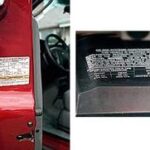It was that time of year again. Time for me to get a new inspection sticker for my old truck. Usually, this is no great problem. The inspection stations in my area are local gas stations really, that are licensed by the state to issue the stickers. One just needs to go over the vehicle and insure that all the lights are working, the tires are in good shape and that the wipers, horn and exhaust system are doing their job as well. Rarely, an inspector will pull off a wheel to inspect brakes or check the ball joints.
This time around however, I had a problem. Rusted out areas on the truck body. A rust hole will fail you in an inspection every time. So some repairs would be in order to help me slide past the inspection yet again.
A stop over at the auto parts store had me carrying out a quart size can of bondo, a second tube of cream harder, a selection of rough and fine sandpaper and a spray can of matching paint. Back at the house I set everything out I would need for this latest repair. I use an orbital sander for small jobs like these and I cut the sandpaper up into the correct sizes to fit in the sander. I used a sharp pocket knife to carve several milk jugs up into handy six by nine inch pieces of plastic. I had a putty knife ready and also a short flat blade screw driver and a stubby stick. And lastly, some plastic window screening material.
Taking the screw driver I went along the rusted areas over the rear wheels and poked and jabbed to discover the really rusted out areas and also bending in the ragged metal. With that done on both sides I loaded the sander up with some coarse grit paper and ran the sander over the rusted areas. This served to remove the surrounding paint and pitted rust spots. That done I cut up a few pieces of the plastic screening and using the screw driver I pushed those pieces into the holes. This measure was to keep the body putty from simply falling through and out the other side.
Next I took one of the carved pieces of plastic from the milk jugs and opening the can of bondo I scooped out a good sized gob onto the plastic. Then I took the cream harder that comes with it and squirted a line of it onto the top of the puddle of bondo. And here is where the stubby stick comes in. You use that stick to stir the hardner into the bondo until the whole mess becomes one color. Usually the bondo is off white and the hardener is a red color. SO..I am looking for pink when mixed. But this is something you don’t want to fool around taking your time with. That cream hardener is a catalyst. It will begin causing the bondo to start hardening as soon as it is being mixed in. If you wait even 5 minutes..the bondo mix will be too stiff to apply and spread.
With a good pink color to it I use the putty knife to apply the bondo to the rusted out areas over the fender. Initially, I just stuff all the bondo in there regardless of looks. I just want to fill the hole up. By the time I finish, the putty has become very stiff and unworkable. I lay this piece of plastic to one side and pick up the other piece. I again mix a batch of bondo and using the putty knife, which by the way, I had to clean off with a pocket knife, to apply the bondo to the other fender. Once done here, I again pick up the first piece of plastic..and working the putty knife under the now completely hardened putty, I am able to peel it off of the plastic. This piece is now ready to use again. I mix up another batch of bondo and go over to the first fender I began working on. This batch of putty will completely fill the cavity and raise the level of bondo above the level of the fender. This is just what we want it to do as once hard..we can sand the high spots down until it is level with the metal of the fender. Then, we can spray primer on the bondo and later give it a coat of paint.
Both fenders get the same treatment and after a good bit of sanding I wipe off the dust and give the fenders a squirt of primer and then a coat of paint. This repair is not intended to fool anybody especially the guy doing the inspection. It is simply to close the rust holes and allow the vehicle to pass inspection.
I have always timed my inspections to occur in warm weather. This lets me complete any needed repairs without having to shiver in the cold while doing them. I drove my truck over to the busiest inspection spot I could find. With a line of people and cars waiting the inspector guy is in somewhat of a hurry and is unlikely to want to pull a wheel off, or be difficult about anything. Soon enough I am in and out with a new sticker and I am good to go for another year.




